The regular change of the physical quantity about the central points is known as oscillation. The state is changed between two extreme points.
The maximum displacement of the oscillation from the mean position to either side of points is known as the amplitude of oscillation. It is also stated as the magnitude of change of oscillating quantity.
The constant to and fro movement of any variable or object between two fixed points is known as oscillation. The peak value or displacement that the oscillating object reaches is known as its amplitude. The pendulum, springs, guitar strings are all examples of oscillation. In the figure given above, the ball moves from point O to point A and then from there to point O then to B. On calculating the length between O and A or O and B we get the amplitude of the oscillation.
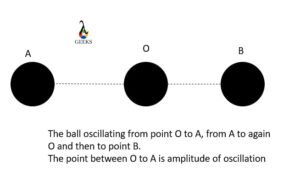
Amplitude of oscillation formula
The amplitude of oscillation is represented as A. For the full range oscillation, the magnitude is derived as 2A. Since oscillation is a periodic function, its wave equation is represented as a sine or cosine function. The formula for the amplitude of the oscillation is;
x = A sin ωt
or
x = A cos ωt
x is the displacement of the particle
A is the maximum amplitude
ω is the angular frequency
t is the time interval
Φ is phase shift
Frequency of oscillation units
The frequency provides you with the knowledge of oscillations made per unit second. It is also stated as the cycle completed in 1 second. One cycle means one complete oscillation.
The frequency is represented as f. The relationship between the frequency and time period is given as;
f = 1/T
f is the frequency and T is the time period of the oscillation.
The S.I unit of frequency is given as;
f = 1 cycle / 1 second
Hence the unit of frequency is Hertz, Hz.
Amplitude of oscillation spring
The motion of a spring is an example of oscillation. When we press or pull the spring, it comes into continuous motion. This type of continuous motion is known as simple harmonic motion.
The spring can be in two arrangements;
Vertical System
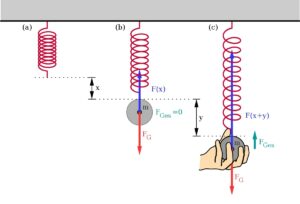
Here as shown in the figure, the string is fixed at a point and hanging vertically. When the load hangs on the spring it stretches to the length y and then starts oscillating. The figure shows the maximum and minimum displacement as +A and -A.
The angular frequency is given as:
t = k/m
Where;
t = 2f
The solution equation of the spring oscillation is:
x = A sin ωt
Horizontal System

The amplitude of any kind of simple harmonic motion is using the given equation;
x = A sin ωt
The energy changes at every point between kinetic and potential energy. The total energy always remains constant. Hence, we get;
Etotal = U + k
The position and velocity equation of the oscillation is defined as;
x = A cos ωt
Using the trigonometric identity:
cos2 + sin2 = 1
and
ω2 = k/m
We get:
Etotal = 1/2 KA2
This equation represents the relationship between the total energy of the spring system and the amplitude. Hence the given equation is used to calculate the amplitude of spring oscillation.
Amplitude of oscillation pendulum
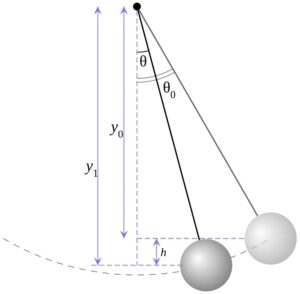
A pendulum is a small bob tied to a thread. It swings to generate oscillation. The amplitude of pendulum oscillation is measured as the maximum displacement that a bob covers starting from the central position. The central position is the initial position of the bob when it is in the rest position. Some refer to this as origin or equilibrium position. The pendulum moves back and forth starting from this point. The largest distance that the bob covers on either side is its “amplitude.” On both sides, the amplitude remains the same. For instance, if a bob covers 3 cm on the left side, it will displace to the same extent on the right side.
Amplitude of oscillation units
The ampitude is the maximum length that a particle covers from its equilibrium position. Since amplitude is a distance travelled hence its unit is a meter that is ‘m’. The meter is the standard unit of amplitude, but other units are also used. Kilometre km’, centimetre cm,’ and millimetre mm’ are some other units.
Amplitude of oscillation of simple pendulum
The simple pendulum is a particular type of pendulum whose bob’s size is much smaller than the distance of the object’s centre of gravity and point of suspension. The amplitude of the simple pendulum does not have any effect on the time period. With the increase in amplitude, the restoring force also increases, which cancels out the effect.
On comparing the oscillation of simple pendulum with the uniform circular motion we get the following solution equation;
x = A cos ωt
x for instantaneous displacement
ω is the angular frequency
t is for time intervals.
This equation is used when the starting point of the pendulum oscillation is taken as the extreme point. In case the oscillation starts from the mean position, the equation becomes;
x = A sin ωt
Amplitude of oscillation diagram
Oscillation is a simple harmonic motion whose equation can be represented as a function of sine and cosine. Hence its diagram is depicted as a wave graph.
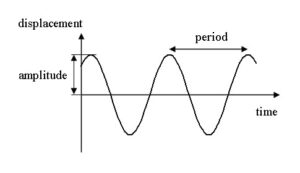
If an oscillating variable undergoes regular back and forth motion, then the peak value that the particle displaces gives out the amplitude of the variable. For all types of diagrams, the amplitude remains the same: the maximum displacement of waves.
Amplitude of oscillation of a particle
The absolute length of vibration or displacement of a sinusoidal oscillation from the equilibrium position is its amplitude. It is the maximum size of a periodically varying particle. The difference of any physical particle from its extreme position and mean position determines its amplitude.
It simply tells us the magnitude of the particle oscillation. The formula for sinusoidal oscillations is;
y = A sin ωt
where | A | is the absolute value of A.
The amplitude variable represents a sinusoidal oscillation. It provides the deflection of a particle from its mean point to a positive or negative value. The particle displacement is particle amplitude. A transverse wave can be described with its distinguished amplitude. Every particle frequency, such as a string, pendulum, and spring, has an amplitude.
How to find amplitude of oscillation
To find the amplitude of oscillation, the general formula used is;
x = A sin ωt + Φ
Where,
x is the displacement of the particle
A is the maximum amplitude
ω is the angular frequency
t is the time interval
Φ is a phase shift.
For instance, a pendulum is swinging with angular speed = π radians and phase shift = 0. Then the amplitude of the pendulum, which covers 14 cm in 8.50 seconds are;
x = A sin ωt + Φ = A sint (0.14*0.85) + 0 = 146 cm
Then the amplitude can be easily found by examining the equation. In this case, the amplitude is 6.
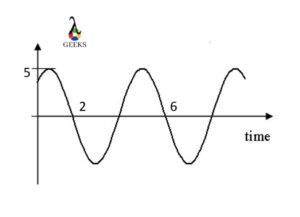
The next case is when the graph of the oscillation is provided. Here we can see the maximum displacement of the wave on either side is. Hence the amplitude is 5.
Frequency of oscillation of a spring-mass system
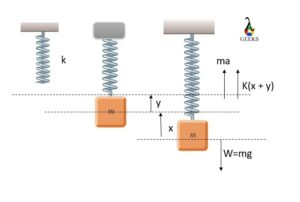
In the above spring-mass system on adding the load the spring displaces to distance y and the oscillation stretches it to a further x position.
According to Hooke’s law.
F=ky
From the diagram, we can see that
W = mg = ky
From the free body diagram, we can see that weight is acting downward. Inertia force that is ma is acting upward and restoring force that is k(x+y) is also acting upward.
We will get:
ma + k (x+y) – W = 0
We know that W= ky, hence we get:
ma + kx = 0
Dividing by m:
a + k/m x = 0
On comparing it with the SHM equation we get:
f = 1/2 √k/m
This is the frequency of the spring-mass system oscillation.
Frequently Asked Questions (FAQs)
What is oscillation?
The oscillation occurs in every area of physics and day-to-day life.
The oscillation is the repetitive too and fro motion of a particle, object, or quantity in time. The oscillating particles move about the mean position to the extreme points on either side. Simple pendulum, spring, playground swings are all examples of oscillation.
How are oscillation and periodic motion different?
The motion can be of two types oscillation or periodic motion.
The periodic motion is the regular movement of a particle at regular intervals. At the same time, oscillation is just the back-and-forth motion of a vibrating object. Every oscillatory motion is periodic, but the converse need not be true. The earth revolves around the sun, which is a periodic function as it keeps repeating itself after a fixed time. A swing is an oscillatory object.
What is the amplitude of oscillation?
The repetitive motion of a particle is known as oscillation.
The extent to which a particle can displace is its amplitude. The displacement is measured from the mean position to either side of the extreme position. ‘A’ represents the amplitude of oscillation, and its standard unit is meter.
Is oscillation a simple harmonic motion?
The motion proportional to the displacement and under the effect of retarding force is known as simple harmonic motion.
The SHM is an oscillatory motion. Or we can say that oscillation is a simple harmonic motion. For example, the spring moves under the influence of Hooke’s law, and its motion is proportional to displacement. Hence it is an SHM oscillation.
What is the equation of oscillating particles?
The oscillation is the simple harmonic motion.
The equation of oscillation is as follow;
x = A sin ωt + Φ
Where,
x is the displacement of the particle
A is the maximum amplitude
ω is the angular frequency
t is the time interval
Φ is phase shift
Hi,
I am Rabiya Khalid, I have completed my masters in Mathematics. Article writing is my passion and I have been professionally writing for more than a year now. Being a science student, I have a knack for reading and writing about science and everything related to it.
In my free time, I let out my creative side on a canvas.